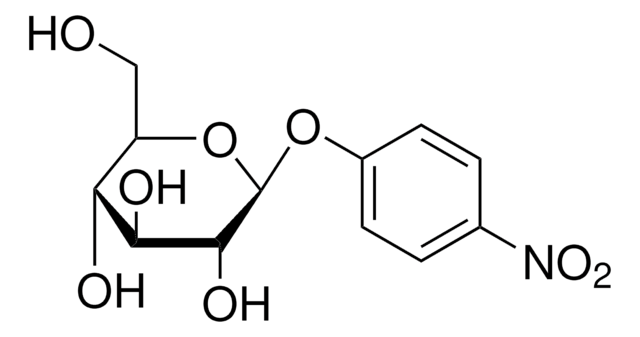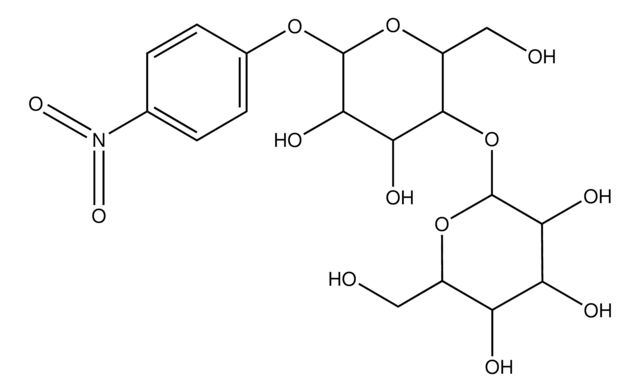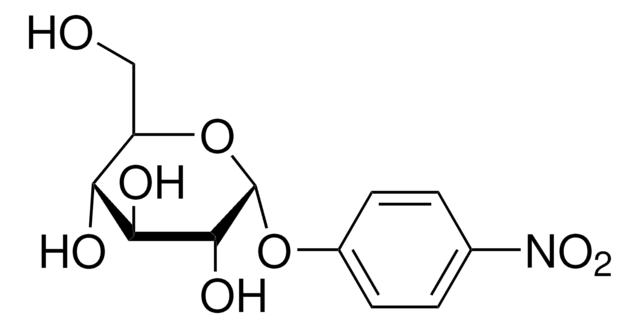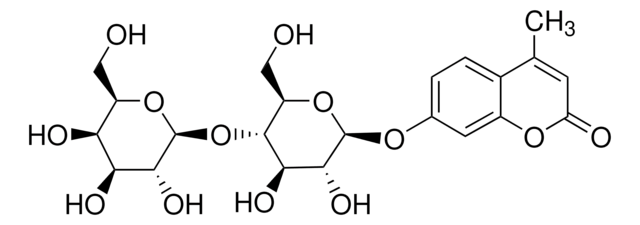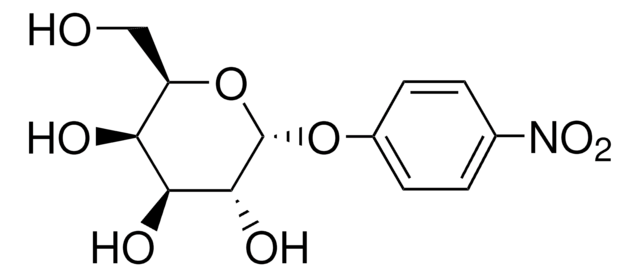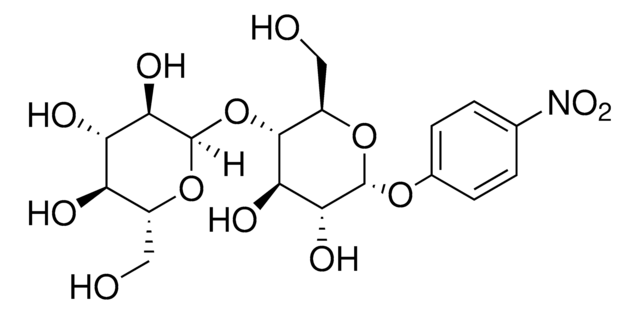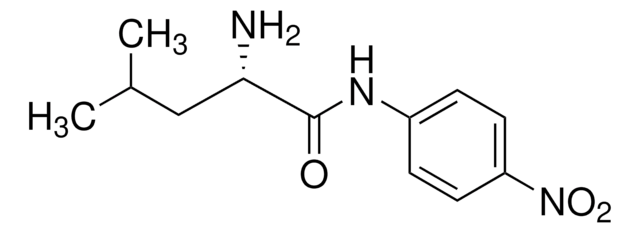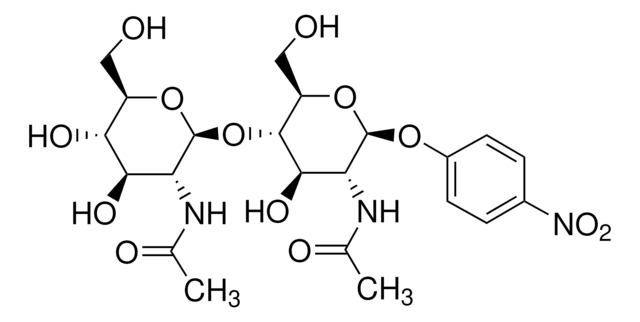추천 제품
제품명
4-Nitrophenyl β-D-cellobioside, ≥98% (TLC)
Quality Level
분석
≥98% (TLC)
양식
powder
solubility
water: 49.00-51.00 mg/mL
저장 온도
2-8°C
SMILES string
OC[C@H]1O[C@@H](O[C@H]2[C@H](O)[C@@H](O)[C@@H](O[C@@H]2CO)Oc3ccc(cc3)[N+]([O-])=O)[C@H](O)[C@@H](O)[C@@H]1O
InChI
1S/C18H25NO13/c20-5-9-11(22)12(23)14(25)18(30-9)32-16-10(6-21)31-17(15(26)13(16)24)29-8-3-1-7(2-4-8)19(27)28/h1-4,9-18,20-26H,5-6H2/t9-,10-,11-,12+,13-,14-,15-,16-,17-,18+/m1/s1
InChI key
IAYJZWFYUSNIPN-KFRZSCGFSA-N
유사한 제품을 찾으십니까? 방문 제품 비교 안내
애플리케이션
4-Nitrophenyl β-D-cellobioside has been used as a substrate to assay β-D-celluliosidase or cellobiohydrolase (exocellulase) activity in the microbial community. It has also been used as a substrate to study the endoglucanase J30 activity.
생화학적/생리학적 작용
4-Nitrophenyl β-D-cellobioside is a cellotriose analog, and a chromogenic substrate commonly used for the detection of cellulase activity. Exoglucanase, endoglucanase and β -glucosidase hydrolyze 4-nitrophenyl β-D-cellobioside to form p-nitrophenol (PNP).
Storage Class Code
11 - Combustible Solids
WGK
WGK 3
Flash Point (°F)
Not applicable
Flash Point (°C)
Not applicable
개인 보호 장비
Eyeshields, Gloves, type N95 (US)
이미 열람한 고객
The competitive inhibition of Trichoderma reesei C30 cellobiohydrolase I by guanidine hydrochloride.
J Woodward et al.
FEBS letters, 270(1-2), 143-146 (1990-09-17)
The p-nitrophenylcellobiosidase (PNPCase) activity of Trichoderma reesei cellobiohydrolase I (CBH I) was competitively inhibited by concentrations of guanidine hydrochloride (Gdn HCl) that did not affect the tryptophan fluorescence of this enzyme. The Km of CBH I, 3.6 mM, was increased
G Henriksson et al.
European journal of biochemistry, 259(1-2), 88-95 (1999-01-23)
A 28-kDa endoglucanase was isolated from the culture filtrate of Phanerochaete chrysosporium strain K3 and named EG 28. It degrades carboxymethylated cellulose and amorphous cellulose, and to a lesser degree xylan and mannan but not microcrystalline cellulose (Avicel). EG 28
Bin Wu et al.
Science in China. Series C, Life sciences, 51(5), 459-469 (2008-09-13)
Conformational changes to 1,4-beta-D-glucan cellobiohydrolase I (CBHI) in response to its binding with p-nitrophenyl beta-D-cellobioside (PNPC) were analyzed by second-derivative fluorescence spectrometry at the saturation binding point. Irreversible changes to the configuration of PNPC during the course of the binding
K Ohmiya et al.
Journal of bacteriology, 161(1), 432-434 (1985-01-01)
An enzyme active against p-nitrophenyl-beta-D-glucoside was purified from logarithmic-phase cells of Ruminococcus albus cultivated in a medium containing ball-milled cellulose. The purification yielded homogeneous enzyme after an approximately 520-fold increase in specific activity and a 9% yield. The enzyme was
Daniel J Coleman et al.
Analytical biochemistry, 371(2), 146-153 (2007-10-12)
A simple and reliable continuous assay procedure for measurement of cellulase activity from several species using the new substrate resorufin-beta-D-cellobioside (Res-CB) has been developed. The product of enzyme reaction, resorufin, exhibits fluorescence emission at 585 nm with excitation at 571
자사의 과학자팀은 생명 과학, 재료 과학, 화학 합성, 크로마토그래피, 분석 및 기타 많은 영역을 포함한 모든 과학 분야에 경험이 있습니다..
고객지원팀으로 연락바랍니다.